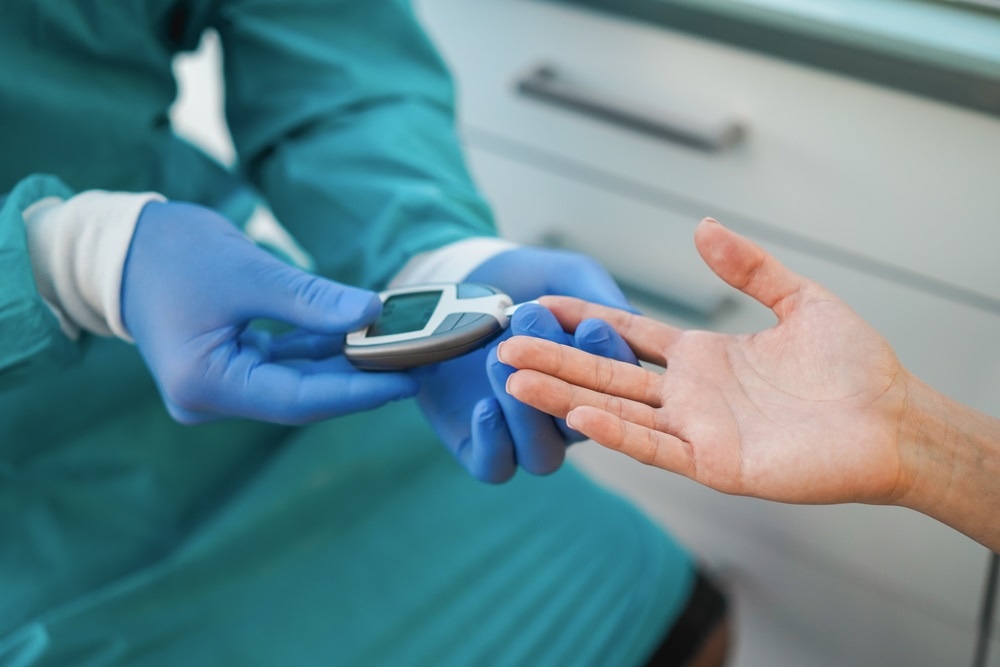COVID-19 and Diabetes
The coronavirus disease 2019 (COVID-19) continues to spread rapidly across the globe. Although people of all ages and backgrounds are at risk of becoming infected, older people and those with concomitant diseases are at the most risk of being critically affected. Analysis of health records of patients who have died from COVID-19 show that over 75% have at least one pre-existing condition. Diabetes appears to be one of the most important comorbid diseases linked to the severity of COVID-19.
 Image Credit: DisobeyArt / Shutterstock.com
Image Credit: DisobeyArt / Shutterstock.com
Epidemiology
Diabetes is an established risk factor for infections, particularly for hospital admission for respiratory tract infections. During previous and similar disease outbreaks such as severe acute respiratory syndrome (SARS) and Middle Eastern respiratory syndrome (MERS), people with diabetes were at an increased risk of developing the infectious disease. In the current pandemic, it is yet unknown whether patients with diabetes are more likely to catch COVID-19. However, a large body of research has shown a significantly higher incidence of diabetes in patients with severe COVID-19.
Data collected from hospitals in Wuhan, China early in the pandemic found that diabetic patients hospitalized with COVID-19 were significantly more likely to require admission to intensive care and had a higher probability of developing serious complications including cardiac injury and secondary infections.
One British study published in The Lancet in August 2020, which included data from 98% of general practices in England found that during the first COVID-19 peak, an additional 3500 people with diabetes died per week from COVID-19. The same study found that one-third of people who had died in hospital from COVID-19 in England from March 1 to May 11 2020 were diabetic. Multiple studies have now associated both type 1 and type 2 diabetes with a substantial increased mortality in COVID-19.
Risk factors
Although diabetes has clearly been identified as a risk factor for severe COVID-19 and mortality, there are additional risk factors within the diabetic population that may elevate risk further. Understanding these risks could help diabetic individuals self-manage more effectively and inform clinical services which support patients. Risk factors identified to date include:
Blood sugar levels prior to infection with COVID-19.
Patients with type 1 and type 2 diabetes and high blood sugar levels have significantly poorer COVID-19-related outcomes than diabetic people with lower blood sugar.
Obesity
Diabetic patients with a high body mass index (above 30.0) are at a significantly higher risk of mortality from COVID-19 than diabetics with a lower body mass index. This is especially true of younger patients and those with non-white ethnicity.
Previous health problems
Impaired renal function and a medical history including stroke or heart failure increase the risk of death from COVID-19 in people with type 1 and type 2 diabetes. A previous admission to hospital for a heart attack increases the risk for people with type 2 diabetes.
Potential mechanisms
Hyperglycemia
Hyperglycemia (high blood glucose) is a symptom that characterizes diabetes, particularly poorly controlled diabetes. It occurs when the body has too little insulin or cannot utilize insulin effectively. Poor glycemic control has been shown to significantly increase the risk of death from COVID-19 in those with and without a prior diagnosis of diabetes, and random hyperglycemia during hospital admissions for COVID-19 significantly worsens prognosis. An unusually high number of patients with COVID-19 have developed ketoacidosis, a serious complication of diabetes related to very high blood sugar levels.
In laboratory studies, elevated levels of glucose directly increase the replication of the SARS-CoV-2 virus. In patients, it has been hypothesized that increased blood sugar might increase COVID-19 severity by increasing the glycosylation of the angiotensin-converting enzyme 2 (ACE2) receptor. ACE2 is an enzyme involved in lowering blood pressure and inflammation and is found on the surface of many cell types. The SARS-CoV-2 virus spike protein can bind to ACE2, which acts as a ‘cellular doorway’ for the virus. Increased glucose in the bloodstream potentially increases glycosylation of ACE2 and of the virus spike protein, which in turn may increase the cellular intrusion of SARS-CoV-2 and the associated immune response.
Inflammation
The SARS-CoV-2 virus infects the cells of the upper respiratory system and the lungs but also circulating T cells. T cells play a critical role in the innate immune system, and the COVID-19 virus may change how they respond. In some cases, this may cause the over-secretion of cytokines. This hyper-inflammatory response is known as a cytokine storm. High blood biomarkers of inflammation and increased blood concentrations of cytokines have been associated with COVID-19 severity and death.
Patients with diabetes are at increased risk of developing the cytokine storm, as diabetes is associated with chronic, elevated systemic inflammation. Furthermore, patients with diabetes may have a reduced immune system response, increasing their risk of developing more severe COVID-19.
Can COVID-19 trigger diabetes?
Diabetes is a clear risk factor for developing severe COVID-19 and mortality from the disease. However, evidence is emerging that the relationship between the two diseases is bi-directional. Studies have tentatively suggested that rates of diabetes diagnoses were higher than expected in 2020.
Cases of new-onset diabetes and severe complications of pre-existing diabetes have been reported in patients with COVID-19. One hypothesis is that when the SARS-CoV-2 virus binds with ACE2 receptors, cells are unable to perform their typical metabolic processes which results in alterations of glucose metabolism. At present, it is unclear who may be vulnerable to this mechanism, or whether glucose metabolism changes persist or remit after recovery from COVID-19.
References
- Apicella, M., Campopiano, M. C., Mantuano, M., Mazoni, L., Coppelli, A., & Del Prato, S. (2020). COVID-19 in people with diabetes: understanding the reasons for worse outcomes. The lancet. Diabetes & endocrinology, 8(9), 782–792. https://doi.org/10.1016/S2213-8587(20)30238-2
- Barron, E., Bakhai, C., Kar, P., Weaver, A., Bradley, D., Ismail, H., Knighton, P., Holman, N., Khunti, K., Sattar, N., Wareham, N. J., Young, B., & Valabhji, J. (2020). Associations of type 1 and type 2 diabetes with COVID-19-related mortality in England: a whole-population study. The lancet. Diabetes & endocrinology, 8(10), 813–822. https://doi.org/10.1016/S2213-8587(20)30272-2
- Holman N, Knighton P, Kar P, et al. Risk factors for COVID-19-related mortality in people with type 1 and type 2 diabetes in England: a population-based cohort study. Lancet Diabetes Endocrinol 2020;8(10):823– 33. https://doi.org/10.1016/ S2213-8587(20)30271-0
- Smith, S. M., Boppana, A., Traupman, J. A., Unson, E., Maddock, D. A., Chao, K., Dobesh, D. P., Brufsky, A., & Connor, R. I. (2020). Impaired glucose metabolism in patients with diabetes, prediabetes, and obesity is associated with severe COVID-19. Journal of medical virology, 10.1002/jmv.26227. Advance online publication. https://doi.org/10.1002/jmv.26227
- The Global Registry of New-Onset, COVID-19-Related Diabetes, CoviDiab Registry, Feb. 2021, covidiab.e-dendrite.com/introduction.html.
Further Reading
- All Coronavirus Disease COVID-19 Content
- Plasma Donation and COVID-19
- COVID-19 and Headache
- COVID-19 and Diarrhea
- What Does COVID-19 do to the Lungs?
Last Updated: Feb 25, 2021

Written by
Clare Knight
Since graduating from the University of Cardiff, Wales with first-class honors in Applied Psychology (BSc) in 2004, Clare has gained more than 15 years of experience in conducting and disseminating social justice and applied healthcare research.
Source: Read Full Article
